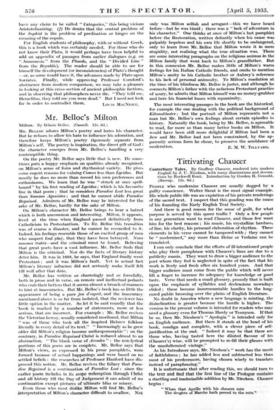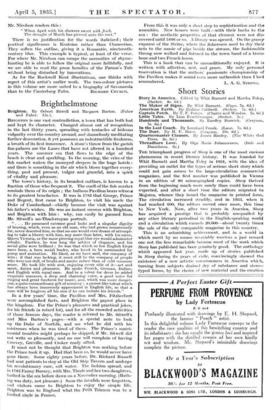Tittivating Chaucer
Canterbury Tales. By Geoffrey Chaucer, rendered into modern English by J. U. Nicolson, with many illustrations and decora- tions by Rockwell Kent. Introduction by Gordon H. Gerould. (Harrap. 12s. 6d.) PEOPLE who modernize Chaucer are usually dogged by a guilty conscience. Walter Sk-eat is the most signal example.
His whole public life was an expiation of his private renderings of the sacred text. I suspect that this goading was the cause of his founding the Early English Text Society.
And there is good reason for the sense of guilt, for what purpose is served by this queer traffic ? Only a few people in any generation want to read Chaucer, and those few want him for the best reasons ; his music, his crystalline hardness of line, his clarity, his personal elaboration of rhythm. These elements in his verse cannot be tampered with ; they cannot be "modernized," any more than Heine or Verlaine can be translated.
I can only conclude that the efforts of ill-intentioned people who play their paraphrase with Chaucer's lines are due to a publicity mania. They want to draw a bigger audience to the poet whom they feel is neglected in spite of the fact that his work is lively and fresh after six hundred years. And that bigger audience must come from the public which will never lift a finger to increase its adequacy for knowledge or good taste. Verse that needs a small glossary, prosody that is built upon the emphasis of syllables and declensions nowadays elided ; these become insurmountable hurdles to the long- eared public browsing over the plains of English literature.
No doubt in America where a new language is minting, the disinclination is greater because the hurdle is higher. The version in the present volume is intended for readers who may need a glossary even for Thomas Hardy or Tennyson. If that be so, then Mr. Nicolson's " Apologia " is intended only for an English audience. But there it stands at the head of his book, condign and complete, with a clever piece of self- justification at the end. "Indeed it may be that them are those who, having tasted here the diluted flavour of his (Chaucer's) wine, will be prompted to re-fill their glasses with the unadulterated vintage."
As his Introducer says, Mr. Nicolson's "work has the merit of faithfulness ; he has added less and subtracted less than most of his predecessors, having chosen wisely to translate instead of paraphrasing."
It is unfortunate that after reading this, we should turn to the text and find that the first line of the Prologue contains a startling and inadmissible addition by Mr. Nicolson. Chaucer begins : "Whim that Aprille with his shoures sote
The clroghte of Marche bath perced to the rote."
Mr. Nicolson renders this :
"When April with his showers sweet with fruit,
The drought of March has pierced unto the root."
There is no justification for the words italicized ; their poetical significance is Keatsian rather than Chaucerian. They soften the outline, giving it a Romantic, nineteenth- century blur. This example is typical, at least of the verse. For where Mr. Nicolson can escape the necessities of rhyme- hunting he is able to follow the original more faithfully, and we are able to read the prose homilies of the Parson's Tale without being disturbed by innovations.
As for the Rockwell Kent illustrations, one thinks with regret of this artist's earlier work. The two-colour pictures in this volume are more suited to a biography of Savonarola
than to the Canterbury Tales. RICHARD CHURCH.











































 Previous page
Previous page